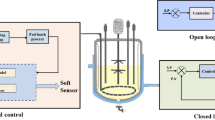Abstract
The behaviour of dry baker’s yeast (Saccharomyces cerevisiae type II, Sigma) used as biocatalyst without preliminary growth for the synthesis of 2-heptanol from 2-heptanone in a biphasic system is presented. Cells undergo intracellular trehalose consumption with a stoichiometric ethanol production during the first 15 h of the process. This metabolism is then replaced by acetate accumulation. These reactions are disconnected from the biocatalytic reaction and do not provide reduced cofactors. 2-Heptanone is metabolised by two pathways. The first leads to 2-heptanol (molar yield close to 55%, enantioselectivity higher than 99%, with a slight decrease at the end of the process) and the second corresponds to material incorporation into the biomass. This latter phenomenon is assumed to provide the biocatalyst with the reduced cofactors needed for the reduction process. Overall, the process yielded ca. 1.4 g/l 2-heptanol in 50 h reaction, which is close to that observed with fresh cells previously grown for 15 h.




Similar content being viewed by others
References
Bakker BM, Bro C, Kotter P, Luttik MAH, van Dijken JP, Pronk JT (2000) The mitochondrial alcohol dehydrogenase Adh3p is involved in a redox shuttle in Saccharomyces cerevisiae. J Bacteriol 182:4730–4737
Boze H, Moulin G, Galzy P (1995) Production of microbial biomass. In: Rehm HJ, Reed G, Puhler A, Stadler P (eds) Biotechnology, vol 9. VCH, Weinheim, pp 167–220
Denis CL, Ferguson J, Young ET (1983) mRNA levels for the fementative alcohol dehydrogenase of Saccharomyces cerevisiae decrease upon growth on a nonfermentable carbon source. J Biol Chem 258:1165–1171
Dickinson FM, Dack S (2001) The activity of yeast ADH I and ADH II with long-chain alcohols and diols. Chem Biol Interact 130–132:417–423
Fontanille P, Larroche C (2003) Optimization of isonovalal production from α-pinene oxide using permeabilized cells of Pseudomonas rhodesiae CIP 107491. Appl Microbiol Biotechnol 60:534–540
Gervais TR, Carta G, Gainer JL (2000) Effect of aeration during cell growth on ketone reactions by immobilized yeast. Biotechnol Prog 16:208–212
Griffin DR, Gainer JL, Carta G (2001) Asymmetric ketone reduction with immobilized yeast in hexane: biocatalyst deactivation and regeneration. Biotechnol Prog 17:304–310
Heidlas J, Engel KH, Tressel R (1991) Enantioselectivities of enzymes involved in the reduction of methyl ketones by baker’s yeast. Enzyme Microb Technol 13:817–821
Larroy C, Fernandez MR, Gonzalez E, Pares X, Biosca JA (2003) Properties and functional significance of Saccharomyces cerevisiae ADH VI. Chem Biol Interact 143–144:229–238
Leskovac V, Trivic S, Pericin D (2002) The three zinc-containing alcohol dehydrogenases from baker’s yeast, Saccharomyces cerevisiae. FEMS Yeast Res 2:481–494
Long A, Ward OP (1989) Biotransformation of benzaldehyde by Saccharomyces cerevisiae: characterization of the fermentation and toxicity effects of substrates and products. Biotechnol Bioeng 34:933–941
Maugard T, Lamare S, Legoy MD (2001) Gas phase biotransformation reaction catalyzed by baker’s yeast. Biotechnol Bioeng 73:164–168
Molinari F, Bertolini C, Aragozzini F (1998) Microbial biotransformations in biphasic systems: formation of R-2-alkanols by methylketone reduction. Biocatal Biotransform 16:87–94
Nikolova P, Ward OP (1992) Reductive biotransformation by wild type and mutant strains of Saccharomyces cerevisiae in aqueous-organic solvent biphasic systems. Biotechnol Bioeng 39:870–876
Orlich B, Berger H, Lade M, Schomäcker R (2000) Stability and activity of alcohol dehydrogenases in w/o-microemulsions: enantioselective reduction including cofactor regeneration. Biotechnol Bioeng 70:638–646
Peterson GL (1977) A simplification of the protein assay method of Lowry et al. which is more generally applicable. Anal Biochem 83:346–356
Slein MW (1965) d-Glucose determination with hexokinase and glucose 6-phosphate dehydrogenase. In: Bergmeyer HU (ed) Methods in enzymatic analysis. Academic Press, New York, p 117
Trivic S, Leskovac V (2000) Structure and function of yeast alcohol dehydrogenase. J Serb Chem Soc 65:207–227
Ward OP, Young CS (1990) Reductive biotransformations of organic compounds by cells or enzymes of yeast. Enzyme Microb Technol 12:482–493
Wills C, Martin T (1984) Extracellular conditions affecting the induction of yeast alcohol dehydrogenase II. Biochim Biophys Acta 782:274–284
Author information
Authors and Affiliations
Corresponding author
Rights and permissions
About this article
Cite this article
Cappaert, L., Larroche, C. Behaviour of dehydrated baker’s yeast during reduction reactions in a biphasic medium. Appl Microbiol Biotechnol 64, 686–690 (2004). https://doi.org/10.1007/s00253-003-1500-7
Received:
Revised:
Accepted:
Published:
Issue Date:
DOI: https://doi.org/10.1007/s00253-003-1500-7




